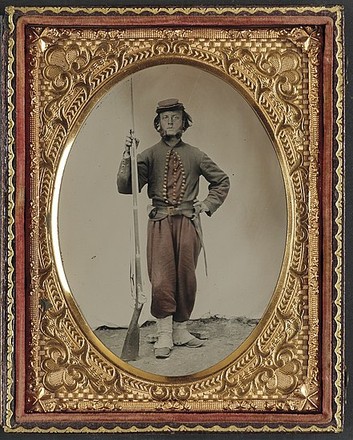General Edward Fowler Monument
Introduction
Text-to-speech Audio
Images
General Edward Fowler Monument

Edward Brush Fowler (1828-1896)

A photograph of a soldier in the Fourteenth Brooklyn

Backstory and Context
Text-to-speech Audio
Edward Brush Fowler was born in Manhattan on May 29, 1828. While he was still an infant, his family moved to Brooklyn. During his teenage years, Fowler studied to become an accountant, but opted instead for a career in the military. He slowly, but steadily rose through the ranks, becoming a first sergeant by his eighteenth birthday in 1846, then a lieutenant by the following year, and then a lieutenant colonel by 1852. In 1847, Fowler joined the newly-formed Fourteenth Regiment New York State Militia (also known as the Fourteenth Brooklyn), composed primarily of tradesmen, businessmen, and firefighters from Brooklyn. Five years later, in 1852, he married Annie Cook. The couple would have three children.
During the Civil War, Fowler and the Fourteenth Brooklyn participated in many of the major battles of the Eastern Theatre. On July 21, 1861, during the First Battle of Bull Run, they fought at Henry House Hill and engaged Confederate troops led by General Thomas “Stonewall” Jackson. For their ferocity and determination in battle and for their red britches, the Confederate commander referred to the men of the Fourteenth Brooklyn as “red-legged devils.” In December 1861, the unit was redesignated as the Eighty-Fourth New York Infantry, but successfully petitioned to continue being referred to as the Fourteenth Brooklyn. The following year, in late August 1862, Fowler and the unit saw combat at the Second Battle of Bull Run. During the engagement, the Fourteenth Brooklyn suffered heavily casualties. Fowler, himself, suffered a wound to the thigh. While recovering in a military hospital in Alexandria, Virginia, he received a promotion to the rank of colonel and was named commandant of the hospital. While Fowler was recovering, the regiment participated in the Battle of Antietam in September and the Battle of Fredericksburg in December. In July 1863, Fowler and the Fourteenth Brooklyn fought honorably at the Battle of Gettysburg, stationed on Culp’s Hill during the second and third day of the engagement. Later, they participated in the Battle of the Wilderness and the Battle of Spotsylvania Court House in May 1864. The following month, the unit was mustered out of federal service and Fowler was brevetted to the rank of brigadier general.
After his service in the Civil War, Fowler returned to Brooklyn. During the final thirty odd years of his life, he served in a variety of positions in local government and the private sector. On January 16, 1896, Fowler died at his Brooklyn home at the age of sixty-seven. Following his death, his body lay in state at Brooklyn Borough Hall before being buried in Greenwood Cemetery.
On May 18, 1902, the City of Brooklyn dedicated a monument in Fowler’s honor. Designed by sculptor Henry Baerer, the monument consists of an over-life-sized bronze statue of the brevet brigadier general dressed in full military attire standing proudly on a cylindrical granite pedestal. He looks out into the distance with his left hand resting on the hilt of his sheathed sword and his right hand on his hip holding his kepi. The monument originally stood in Fort Greene Park, but was moved to storage in the 1960s after years of neglect and vandalism. In 1976, it was placed in Lafayette Square, which was renamed Fowler Square. In 2005, the monument underwent a full restoration.
Sources
"General Edward Fowler Statue." New York City Department of Parks and Recreation. The City of New York. Web. 22 October 2020 <https://www.nycgovparks.org/parks/greenstreet-bz32/history>.
Weible, Robert, Jennifer A. Lemak, and Aaron Noble. An Irrepressible Conflict: The Empire State in the Civil War. Albany, NY: State University of New York Press, 2014.
https://www.nycgovparks.org/parks/greenstreet-bz32/history
https://www.green-wood.com/2013/january-16-edward-brush-fowler/
https://www.npr.org/sections/pictureshow/2012/04/17/150801239/photo-mystery-solved-then-doubted-then-resolved-thanks-to-readers
